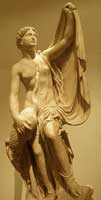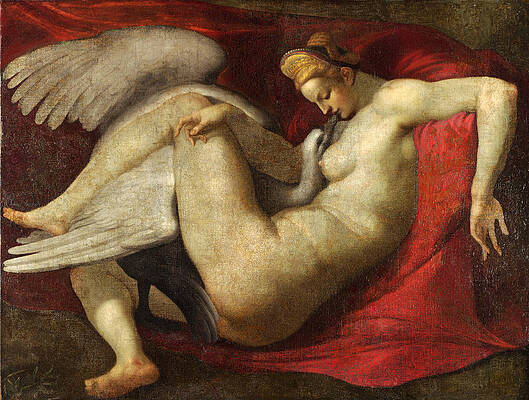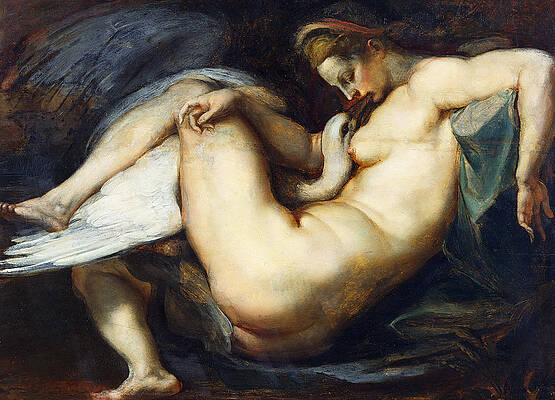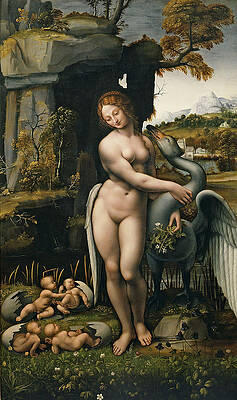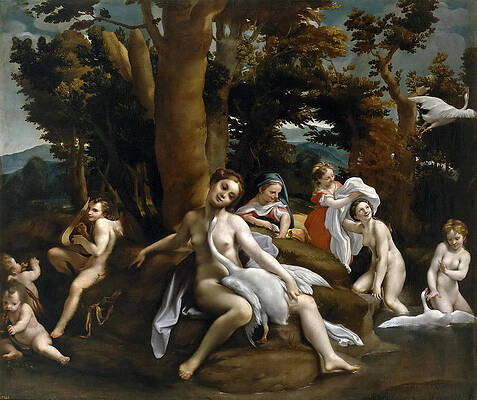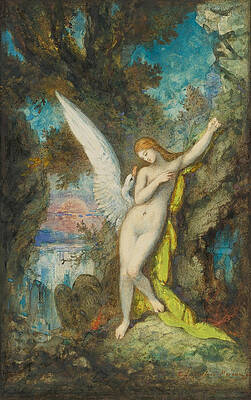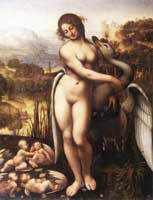.
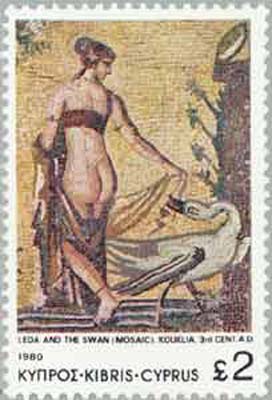
Leda and the swan, Mosaic, 3rd century AD, Kouklia / Cyprus.
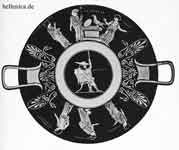
Leda and the egg, Boston99.539 Attributed to Xenotimos Painter, Potter Xenotimos
In Greek mythology, Leda (Λήδα) was a Spartan queen, wife of Tyndareus and mother of the double sets of mixed twins, Castor and Polydeuces and Clytemnestra and Helen, as well as Phoebe and Philonoe.
Leda was seduced by Zeus. As the myth developed, it appeared that on a single night Zeus, in the guise of a swan, lay with Leda, who conceived Polydeuces (Pollux) and Helen "of Troy", and her mortal husband, Tyndareus, king of Sparta, lay with his wife too, with whom she conceived Castor and Clytemnestra. Thus one set of twins were wholly mortal, the other set half-immortal. Homer (Odyssey XI, 298) gives a simpler earlier version.
The motif of Leda and the Swan from Greek mythology, in which the Greek god Zeus came to Leda in the form of a swan, was rarely seen in Gothic art, but resurfaced as a classicizing theme, with erotic overtones, in Italian painting and sculpture of the 16th Century. The most familiar examples are the copies of Leonardo da Vinci's lost painting, with the two sets of infant twins; Correggio's elaborate composition of c. 1530 (Berlin); and two versions of a lost Michelangelo that is also known from an engraving by Cornelis de Bos, c. 1563; the marble sculpture by Bartolomeo Ammanati in the Bargello, Florence; and the painting after Michelangelo, c. 1530, in the National Gallery, London. The Michelangelo composition is a definitive example of Mannerism.
Leda and the Swan furnished a common motif for the visual arts into the 19th century.

Dali's Leda Atomica, 1949, according to the story of Leda and the swan. Leda is the mother of Helen of Troy which Dali painted when he was young. The objects fly around Leda like electrons around a nucleus. Probably Dali was influenced by the advances in Atomic physics. Leda is painted inside a Pentagram, a Pythagorean Symbol.
"Leda And The Swan" is a poem by William Butler Yeats first published in 1924. Reviving what had become an insipid classical cliché by combining psychological realism with a mystic vision, it describes the swan's mating with Leda, mother of Helen of Troy and her sister Clytemnestra, the faithless wife of Agamemnon.
A sudden blow: the great wings beating still
Above the staggering girl, her thighs caressed
By the dark webs, her nape caught in his bill,
He holds her helpless breast upon his breast.
How can those terrified vague fingers push
The feathered glory from her loosening thighs?
And how can body, laid in that white rush,
But feel the strange heart beating where it lies?
A shudder in the loins engenders there
The broken wall, the burning roof and tower1
And Agamemnon dead.
Being so caught up,
So mastered by the brute blood of the air,
Did she put on his knowledge with his power
Before the indifferent beak could let her drop?
"Was this the face that launched a thousand ships/ And burnt the topless towers of Ilium?" (Christopher Marlowe, Doctor Faustus). Both Helen and Clytemnestra were Leda's daughters.
Links
Yeats' "Leda and the Swan": an image's coming of age (http://d-sites.net/english/yeats.htm)
Images
Leda and the Swan, After Michelangelo
Leda and the Swan, Peter Paul Rubens
Leda and the Swan, Correggio
Leda and the Swan, Giambettino Cignaroli
Leda and the Swan, Francesco Melzi
Leda and the Swan, Bacchiacca
The Story of Leda, Eugenio Cajes
Leda and the Swan, Gustave Moreau
Leda, Scott Bodenheimer 1998
* Leda with the Swan Bartolomeo Ammanati ( 1511 - 1592)
Leda Jupiter moon
Asteroid 38 Leda
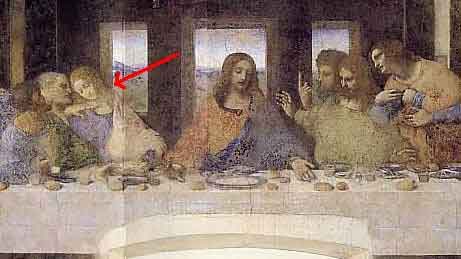

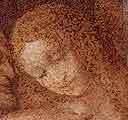
The Last Supper by Leonardo da Vinci, Detail. Similarities of Leda (see first two images) and the figure at the right hand of Jesus who supposedly is not the apostle John, but Mary Magdalene. In fantasy Novels like the Da Vinci Code there are remarks on the color scheme of the garments: Jesus wears a red blouse with royal blue cape; John/Mary wears a royal blue blouse with red cape — perhaps symbolizing some bond.

Leda and the swan, Helge Högbom
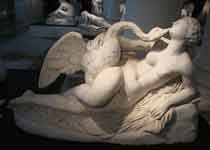
References
Harry Thurston Peck, Harper's Dictionary of Classical Antiquities, 1898.
See also : Greek Mythology. Paintings, Drawings
Greek Mythology Index
A - B - C - D - E - F - G - H - I - J - K - L - M -
N - O - P - Q - R - S - T - U - V - W - X - Y - Z
Α - Β - Γ - Δ - Ε - Ζ - Η - Θ - Ι - Κ - Λ - Μ -
Ν - Ξ - Ο - Π - Ρ - Σ - Τ - Υ - Φ - Χ - Ψ - Ω
| Ancient Greece
Science, Technology , Medicine , Warfare, , Biographies , Life , Cities/Places/Maps , Arts , Literature , Philosophy ,Olympics, Mythology , History , Images Medieval Greece / Byzantine Empire Science, Technology, Arts, , Warfare , Literature, Biographies, Icons, History Modern Greece Cities, Islands, Regions, Fauna/Flora ,Biographies , History , Warfare, Science/Technology, Literature, Music , Arts , Film/Actors , Sport , Fashion --- |
Retrieved from "http://en.wikipedia.org"
All text is available under the terms of the GNU Free Documentation License

